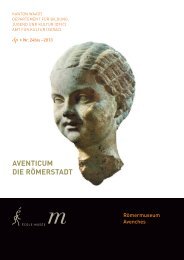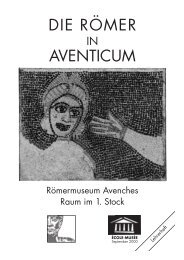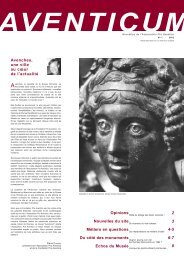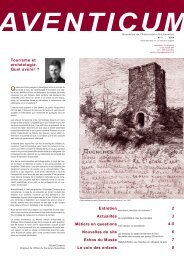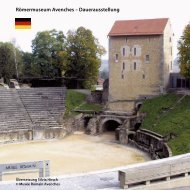Avenches – Roman Museum – Permanent Exhibition
Avenches – Roman Museum – Permanent Exhibition
Avenches – Roman Museum – Permanent Exhibition
You also want an ePaper? Increase the reach of your titles
YUMPU automatically turns print PDFs into web optimized ePapers that Google loves.
Ground Floor The Gallo-<strong>Roman</strong> Population of Switzerland and Their View of Death<br />
Cremation Burials<br />
Child Burials (1)<br />
(Display case and drawer 2)<br />
Inhumation burial of an infant aged four to six months<br />
Port necropolis. Late 1st <strong>–</strong> 2nd centuries AD.<br />
1. Ceramic feeding bottle as grave offering. The infant was buried in a wooden coffin.<br />
Inhumation burial of a few month old infant<br />
En Chaplix necropolis. AD 120 <strong>–</strong> 140.<br />
2. The tableware, consisting of a glass jug and bottle and a small ceramic bowl was<br />
deposited on the coffin.<br />
Inhumation burial of a child aged one to two years<br />
En Chaplix necropolis. Approximately AD 150.<br />
3. The grave goods placed in the lead sarcophagus consisted of two bowls (only one of<br />
which is exhibited) and a glass bead.<br />
Cremation Burials<br />
(Display case and drawer 3)<br />
Cremation burial of a child aged three to four years (2)<br />
En Chaplix necropolis. Approximately AD 125 <strong>–</strong> 130.<br />
The urn, together with a ceramic pot (not burnt), was deposited in a grave as an<br />
offering. Three coins and a silver pendant were found among the burnt and washed<br />
human bone in the urn. Apart from charcoal the grave also contained the remains<br />
of many other offerings, which were burnt on the pyre but only some of which are<br />
exhibited.<br />
1. Glass bottle with two handles, used as urn.<br />
2. Silver pendant and three bronze sestertii (two of Hadrian and one of Domitian),<br />
deposited in the urn with the ashes.<br />
3. Locally produced ceramic pot, not burnt, deposited in the glass urn in the grave.<br />
4. Ceramic tableware, imported from southern Gaul, partly or totally burnt, a bowl, a dish,<br />
a plate and three cups).<br />
5. Locally produced pottery, partially or totally burnt, comprising two jugs, two bowls and<br />
a pot.<br />
6. Several burnt glass vessels including a ribbed cup and a green vessel decorated with<br />
small yellow and brown-red rosettes.<br />
7. Two iron hinges and nails.<br />
8. Penannular fibula, a handle and various other bronze items, all burnt.<br />
9. Two burnt bronze dupondii of Hadrian.<br />
Cremation burial of an adult male, perhaps a shipwright<br />
Port necropolis. Early 2nd century AD.<br />
A wooden box measuring about 35 by 35 cm (not preserved) was used as an urn.<br />
Apart from the burnt bones it contained fragments of iron objects, some of which<br />
may have belonged to the box, as well as three tools, which had not been burnt<br />
1<br />
2<br />
10<br />
Ground Floor<br />
2<br />
3



